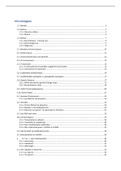Summary
Genetica samenvatting 1e bach
Course
Genetica (D013255A)
Dit is een samenvatting van het vak Genetica 2e semester 1e bach, gegeven door prof Menten. Deze samenvatting is volledig! Het bevat afbeeldingen van de slides om alle uitleg te verduidelijken. Ik heb voor deze samenvatting alle lesvideo's herbekeken, zodat ik alle belangrijke zaken dat gezegd werd...
[Show more]
Preview 4 out of 63 pages
Uploaded on
April 13, 2022
Number of pages
63
Written in
2021/2022
Type
Summary
genetica
1e bach
prof menten
2e semester
complete
ugent
samenvatting
Institution
Universiteit Gent (UGent)
Education
Biomedische Wetenschappen
Course
Genetica (D013255A)
All documents for this subject (6)
By: emmavandecasteele1 • 1 year ago
By: elinhofman • 1 year ago
$10.19
Also available in package deal from $18.79
100% satisfaction guarantee
Immediately available after payment
Both online and in PDF
No strings attached
Also available in package deal (1)
samenvatting van Genetica en Embryologie van de 1e bach biomedische wetenschappen
Inhoudsopgave




